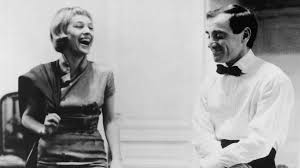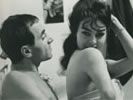Eye For Film >> Movies >> Shoot The Pianist (1960) DVD Review
Shoot The Pianist
Reviewed by: Angus Wolfe Murray
Read Angus Wolfe Murray's film review of Shoot The Pianist
The introduction to the film is a short overview, recorded in 2001, by an unnamed intellectual and is typically French in the sense that it approaches cinema with the seriousness that lit Brits discuss books. He talks of Truffaut "mixing genres disconcertingly" and "being driven by sheer pleasure".
Shoot The Pianist was not successful at the box office, possibly because it is so different from Truffaut's debut, The 400 Blows (Les Quatre Cents Coups), which was universally admired, and became a cult hit in New York.

The audio commentary by cinematographer Raoul Coutard is an interview, rather than a scene-by-scene commentary in the true sense. Originally a photo journalist, Coutard's entrée into film was in Jean-Luc Godard's ground breaking À Bout De Souffle, based on a story by Truffaut, which, in turn, was inspired by the 1949 American film noir Gun Crazy. It was Coutard's handheld footage and location work that created the Nouvelle Vague look, which Truffaut emulated in Shoot The Pianist.
The opening scenes, when Charlie Kohler's brother Chico (Albert Remy) is being chased through the streets at night are good examples of Truffaut's attempt at a new kind of realism. Chico runs from light into darkness, so that half the time the audience can't see what is going on. This was not an intentional kick in the pants to Hollywood's studio-based style, but a question of money (lack of) and electrical failure. Coutard had hung lights in the trees along the path that Remy would take, but the wind blew some of them out and others didn't work. Rather than bring in expensive replacements, Truffaut left it and moved on.
Coutard talks a lot about technical matters, such as the camera he used, the type of film, the lighting and so on. When asked about colour, he says there was never any chance of that.
"New Wave films were low budget. It cost five times as much to make a film in colour in those days and needed ten times as much lighting."
He calls Truffaut "a traditionalist", despite using Godard's technique of limited sound and light. Jules Et Jim, which was Truffaut's next film, "was even more experimental - practically no sound." He talks of Godard, too, how he left a couple of days at the end of shooting a film for inserts, those telling details that illustrate a scene and imply a mood. Truffaut was more instinctive, it seems, and didn't worry too much about what people knew, as long as they were enthusiastic and committed. "Of the grips, only two had had any experience in making films," Coutard says. "The others were friends of François."
Truffaut Talks About Pianist is from a Q & A he gave in 1965, when Truffaut looked like an overgrown student. He is being contentious when he says: "I realised how much I hated gangsters." Which explains why the bad guys in Pianist are comic figures. "All this stuff I find revolting. I don't like brutal, simplistic people."
He says the image that inspired him to make the film was that of a car driving through snow with no sound, which appears right at the end.
"Many people called Pianist a parody," he says, with a tinge of disgust. "I hate parodies. They seem totally anti-artistic."
He is unapologetic, almost arrogant.
"I gain inspiration from books. I am a very realistic director."
So there!
Reviewed on: 08 Oct 2006
















